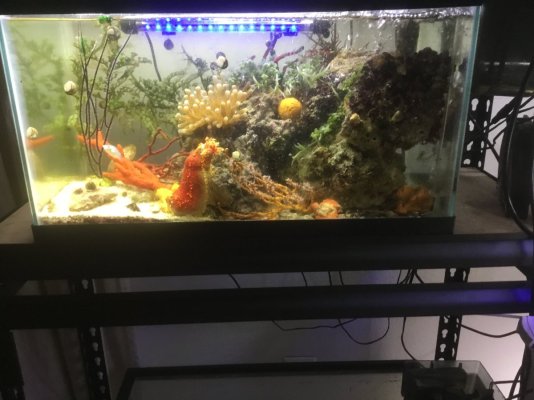Hi,
To preface, I am a total noob with macroalgae. I have extensive experience growing carnivorous plants and some other plants, so I am looking for help.
I am taking care of the volcano shrimp (opae ula, Halocaridina rubra) in a brackish aquarium, ~2.5 gallon. The salinity is 1.014. I do not have other water quality info but I can take a sample to my LFS if this will help narrow down the issue. I read Caulerpa can tolerate around this range of salinity (but I realize it's at the very lowest end of the range and not ideal).
Lighting: 24W full spectrum LED grow light on for 12hr a day. This is quite intense, for my carnivorous plants it is sufficient (which typically require 12+ hrs of extremely intense lighting).
I've tried introducing Caulerpa prolifera and what I believe is C. sertularioides into the tank, but both have eventually whitened and died. This bushy Chaetomorpha (https://www.petshrimp.com/product/supershrimp-macroalgae/) remains alive, but kind of yellow.
The C. prolifera came from an etsy shop before I had the shrimp, so the tank wasn't really cycled yet. The C. sertularioides were cuttings from a mangrove lagoon in Jupiter, FL, which I assumed was brackish due to presence of mangrove trees and puffer fish.
Here is how C. sertularioides looked after introduction:

And today (after a few weeks):


The other algae Chaetomorpha seems quite yellow honestly. So maybe it is a nutrient issue.
I thought it was low nitrogen due to information from the original etsy shop I got the other species at, but now that the tank is several months old with shrimp and a cycled sponge filter, I'm not sure. There was a lot of microalgae growth previously due to a copepod overgrowth, but that went away, which led me to believe that N and P were probably high.
Any ideas? Thanks for taking the time to help,
Ben
To preface, I am a total noob with macroalgae. I have extensive experience growing carnivorous plants and some other plants, so I am looking for help.
I am taking care of the volcano shrimp (opae ula, Halocaridina rubra) in a brackish aquarium, ~2.5 gallon. The salinity is 1.014. I do not have other water quality info but I can take a sample to my LFS if this will help narrow down the issue. I read Caulerpa can tolerate around this range of salinity (but I realize it's at the very lowest end of the range and not ideal).
Lighting: 24W full spectrum LED grow light on for 12hr a day. This is quite intense, for my carnivorous plants it is sufficient (which typically require 12+ hrs of extremely intense lighting).
I've tried introducing Caulerpa prolifera and what I believe is C. sertularioides into the tank, but both have eventually whitened and died. This bushy Chaetomorpha (https://www.petshrimp.com/product/supershrimp-macroalgae/) remains alive, but kind of yellow.
The C. prolifera came from an etsy shop before I had the shrimp, so the tank wasn't really cycled yet. The C. sertularioides were cuttings from a mangrove lagoon in Jupiter, FL, which I assumed was brackish due to presence of mangrove trees and puffer fish.
Here is how C. sertularioides looked after introduction:
And today (after a few weeks):
The other algae Chaetomorpha seems quite yellow honestly. So maybe it is a nutrient issue.
I thought it was low nitrogen due to information from the original etsy shop I got the other species at, but now that the tank is several months old with shrimp and a cycled sponge filter, I'm not sure. There was a lot of microalgae growth previously due to a copepod overgrowth, but that went away, which led me to believe that N and P were probably high.
Any ideas? Thanks for taking the time to help,
Ben



















